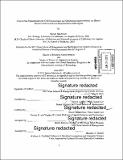| dc.contributor.advisor | Steven J. Spear and Elazer R. Edelman. | en_US |
| dc.contributor.author | Machinani, Suman | en_US |
| dc.contributor.other | Leaders for Global Operations Program. | en_US |
| dc.date.accessioned | 2015-09-29T18:58:13Z | |
| dc.date.available | 2015-09-29T18:58:13Z | |
| dc.date.copyright | 2015 | en_US |
| dc.date.issued | 2015 | en_US |
| dc.identifier.uri | http://hdl.handle.net/1721.1/99012 | |
| dc.description | Thesis: M.B.A., Massachusetts Institute of Technology, Sloan School of Management, 2015. In conjunction with the Leaders for Global Operations Program at MIT. | en_US |
| dc.description | Thesis: S.M., Massachusetts Institute of Technology, Engineering Systems Division, 2015. In conjunction with the Leaders for Global Operations Program at MIT. | en_US |
| dc.description | Cataloged from PDF version of thesis. | en_US |
| dc.description | Includes bibliographical references (pages 48-49). | en_US |
| dc.description.abstract | Background: Medical device manufacturers (suppliers) and hospitals (providers) face financial and operational stressors exacerbated by recent healthcare reform. Providers now face the prospect of decreased reimbursements and financial penalties associated with quality of care metrics while suppliers must cope with product commoditization and increased scrutiny of device cost. To address these financial and operational pressures, suppliers and providers will need to uncover opportunities for cost savings and improvements in clinical care. The consumer packaged goods (CPG) industry provides insight into a vehicle for achieving such results as there exist cases in which collaboration between suppliers and customers have been able to generate financial and operational gains. Question: Given such cases of collaborative success within the CPG space and parallels in supply chain environments between the CPG and medical device industries, we ask: what are the opportunities for cost savings and operational efficiencies that can be realized via collaborative supply chain practices between medical device manufacturers and hospitals? Methodology: We implement a two-step approach to constructing a model that identifies such opportunities. First, to establish the foundational framework for this model, we propose several hypotheses (HI, H2, H3) that relate to the CPG and medical device domains based on existing theory as well as interviews and observations at Device Company X, a leading device manufacturer, and at Hospital X, a Harvard Medical School affiliated teaching hospital. These hypotheses are: H1: Shared practices between suppliers and customers can generate cost containment and operational improvements in the CPG domain. H2: The operating environments between CPG and medical device companies share similarities with respect to operational goals, product characteristics, and logistical pressures. H3: Supply chain shared practices between US medical device companies and hospitals can generate cost containment and operational efficiencies. Second, we propose a collaboration model that can be leveraged to test H3 by building on the core principle of shared practices that underlie a pre-existing collaboration model within the CPG space. To create this model, we examined operations within a procedure suite at Hospital X. This entailed assessing the process steps required for inventory replenishment and product consumption while noting the role of Device Company X in facilitating task execution. Findings: The CPG domain and medical device industry may share similarities within their operating environments. As such, collaboration practices within the CPG space may provide a template for financial and operational solutions that medical device companies and hospitals can benefit from. Building on a prior model used within the CPG space, we propose a collaboration model with three operational levers for hospitals and device manufacturers that may represent sources for cost containment and operational efficiencies. These operational dimensions include physician practice standardization, inventory replenishment, and space utilization. Our model calls for redefining the roles of medical device company personnel within clinical care territories to include greater participation in hospital value-add activities. Next Steps: Device manufacturers and hospitals can test the feasibility of sources for cost containment and operational efficiencies within the proposed collaboration model by implementing survey based modalities to uncover enablers and barriers to collaboration. For both parties, conducting low-stakes, time friendly pilot studies offers a compelling route to "testing the waters" of collaboration. | en_US |
| dc.description.statementofresponsibility | by Suman Machinani. | en_US |
| dc.format.extent | 49 pages | en_US |
| dc.language.iso | eng | en_US |
| dc.publisher | Massachusetts Institute of Technology | en_US |
| dc.rights | M.I.T. theses are protected by copyright. They may be viewed from this source for any purpose, but reproduction or distribution in any format is prohibited without written permission. See provided URL for inquiries about permission. | en_US |
| dc.rights.uri | http://dspace.mit.edu/handle/1721.1/7582 | en_US |
| dc.subject | Sloan School of Management. | en_US |
| dc.subject | Engineering Systems Division. | en_US |
| dc.subject | Leaders for Global Operations Program. | en_US |
| dc.title | Uncovering opportunities for cost containment and operational improvements via shared practices between device manufacturer and hospital | en_US |
| dc.type | Thesis | en_US |
| dc.description.degree | M.B.A. | en_US |
| dc.description.degree | S.M. | en_US |
| dc.contributor.department | Leaders for Global Operations Program at MIT | en_US |
| dc.contributor.department | Massachusetts Institute of Technology. Engineering Systems Division | |
| dc.contributor.department | Sloan School of Management | |
| dc.identifier.oclc | 921189073 | en_US |
